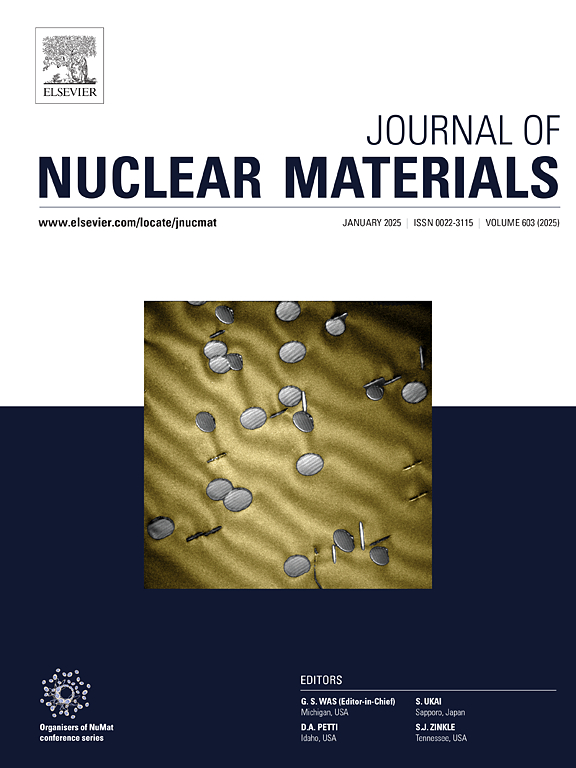Mechanistic insights into spinodal L12 nanostructures in mitigating radiation defect growth in Al0.5Cr0.9FeNi2.5V0.2 high-entropy alloys
IF 2.8
2区 工程技术
Q3 MATERIALS SCIENCE, MULTIDISCIPLINARY
引用次数: 0
Abstract
High-entropy alloys with high-content L12 nanoprecipitates formed through phase separation have recently demonstrated outstanding mechanical properties across a wide temperature range, making them suitable structural materials for advanced nuclear systems. This study investigates the irradiation response of a high-entropy alloy composed of Al0.5Cr0.9FeNi2.5V0.2 with varying volumes of L12 nanostructures. High-temperature He ion irradiation was performed, and its effects on defect evolution were analyzed using transmission electron microscopy and nanoindentation. The results show that the spinodal order-disorder L12 network structure effectively suppresses irradiation-induced defects, as evidenced by reduced dislocation loop size, lower He bubble swelling, and decreased irradiation hardening in alloys with higher L12 volume fractions. This is primarily because the L12 structure, with its low-misfit coherent interface, undergoes the reversible order-disorder transition that reduces early irradiation point defects and suppresses defect nucleation and growth. Furthermore, the spinodal order-disorder L12 nanostructure impedes defect cluster movement by providing diffuse obstacles and forming antiphase boundaries, thereby slowing the growth of defects and He bubbles. This work provides an alloy design strategy to improve irradiation tolerance by exploiting the self-healing and structural complexity of the L12 structure.

求助全文
约1分钟内获得全文
求助全文
来源期刊

Journal of Nuclear Materials
工程技术-材料科学:综合
CiteScore
5.70
自引率
25.80%
发文量
601
审稿时长
63 days
期刊介绍:
The Journal of Nuclear Materials publishes high quality papers in materials research for nuclear applications, primarily fission reactors, fusion reactors, and similar environments including radiation areas of charged particle accelerators. Both original research and critical review papers covering experimental, theoretical, and computational aspects of either fundamental or applied nature are welcome.
The breadth of the field is such that a wide range of processes and properties in the field of materials science and engineering is of interest to the readership, spanning atom-scale processes, microstructures, thermodynamics, mechanical properties, physical properties, and corrosion, for example.
Topics covered by JNM
Fission reactor materials, including fuels, cladding, core structures, pressure vessels, coolant interactions with materials, moderator and control components, fission product behavior.
Materials aspects of the entire fuel cycle.
Materials aspects of the actinides and their compounds.
Performance of nuclear waste materials; materials aspects of the immobilization of wastes.
Fusion reactor materials, including first walls, blankets, insulators and magnets.
Neutron and charged particle radiation effects in materials, including defects, transmutations, microstructures, phase changes and macroscopic properties.
Interaction of plasmas, ion beams, electron beams and electromagnetic radiation with materials relevant to nuclear systems.
 求助内容:
求助内容: 应助结果提醒方式:
应助结果提醒方式:


